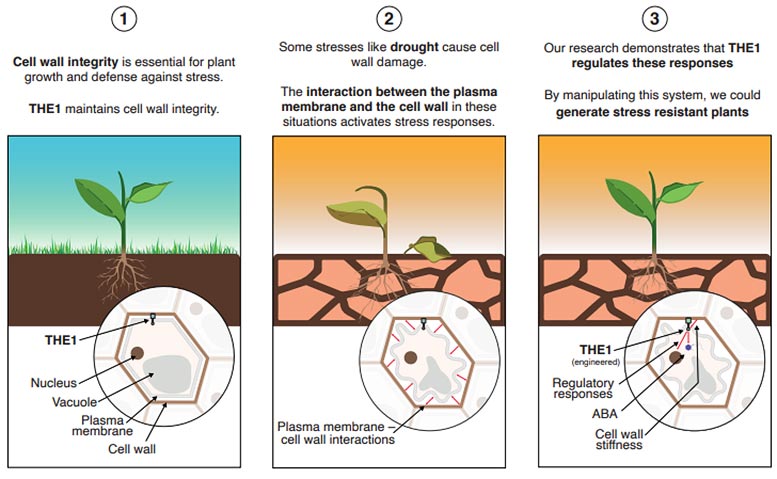
L’illustration montre comment les plantes s’adaptent à la sécheresse. L’hormone THE1 aide à maintenir les parois cellulaires intactes. La sécheresse peut endommager les parois, et le groupe de recherche a découvert que THE1 régule les différents mécanismes de défense déclenchés par la sécheresse. Les chercheurs ont été en mesure de manipuler ces mécanismes, d’identifier les plantes naturelles où le mécanisme de régulation est particulièrement actif et de créer de nouvelles variétés de cultures capables de mieux faire face aux changements. Crédit : NTNU
La hausse des températures affecte les plantes dont l’agriculture – et nous – dépendons. De nouvelles recherches permettent de comprendre comment les plantes résistent à la sécheresse.
Toutes les formes de vie doivent s’adapter à l’environnement dans lequel elles vivent. Un réchauffement du climat peut entraîner des sécheresses plus fréquentes. Cela peut affecter la diversité biologique de la Terre.
Le climat a également un impact sur l’agriculture et toutes les plantes dont nous dépendons pour nous nourrir.
Il est donc important pour l’agriculture – et pour nous tous – d’en savoir plus sur la façon dont les plantes s’adaptent à la sécheresse. Des chercheurs sont sur le coup au NTNU et dans d’autres institutions. Les résultats peuvent nous aider à cultiver des plantes mieux à même de résister à la sécheresse.
Deux facteurs influent sur l’adaptation
“Deux facteurs clés influencent la capacité des plantes à résister au stress de la sécheresse”, explique Thorsten Hamann, professeur au département de biologie de NTNU.
Les parois cellulaires rigides qui entourent les cellules des plantes leur donnent un soutien structurel et réduisent la perte d’eau lorsque les plantes sont exposées à la sécheresse. Le second facteur est l’acide abscissique acid, a hormone that regulates drought adaptation in all land plants.
“Although plant cell walls and abscisic acid are essential for plant life, we know very little about the processes activating abscisic acid production and regulating cell wall stiffness,” says Hamann.
But the planet seems to be changing, and it is important to get ahead of the curve of rising temperatures.
Applied emerging technology
Hamann is currently on a research residency at UCLA in California. His research group examined two model plants, thale cress (Arabidopsis thaliana) and common garden peas (Pisum sativum).
Model plants are plant species that for various reasons are commonly used in experiments and can therefore yield comparable results between different research projects. Another important reason for their use is that the cells of model plants go through a full life cycle in just nine weeks, enabling a quick turnaround for completing experiments with them.
The researchers adapted Brillouin spectroscopy for their experiments, a microscopy technique commonly used in materials technology, but which they were able to adapt to their purpose.
“We used this technique to investigate the tiny fluctuations inside the plant cells that influence cell wall stiffness and the processes regulating it,” says Hamann.
The research group also arrived at results that are startling enough to have been published in the Proceedings of the National Academy of Sciences (PNAS) Journal.
Could be good news for agriculture
“We identified a molecular component, which is required for modulating not only cell wall stiffness but also abscisic acid production,” Hamann says.
This molecular component is called THE1 or Theseus1. Originally, it was found in the thale cress, one of the species that the research group investigated this time as well.
They arrived at even more interesting results by combining several findings from studies on cell biology and the chemical processes behind plant metabolism.
“We found that intact cell walls are absolutely necessary to produce abscisic acid in the plants we examined,” says Hamann.
Without whole cell walls, the plants’ ability to adapt does not function. This is important to know.
“These findings provide novel mechanistic insights into processes responsible for plant adaptation to a changing environment and drought,” Hamann says.
They could also be good news for agriculture if they can help us cultivate plants that can withstand drought better.
Increasing our knowledge “enables us to better improve crop yields using knowledge-based approaches,” Hamann says.
Reference: “THESEUS1 modulates cell wall stiffness and abscisic acid production in Arabidopsis thaliana” by Laura Bacete, Julia Schulz, Timo Engelsdorf, Zdenka Bartosova, Lauri Vaahtera, Guqi Yan, Joachim Matthias Gerhold, Tereza Tichá, Camilla Øvstebø, Nora Gigli-Bisceglia, Svanhild Johannessen-Starheim, Jeremie Margueritat, Hannes Kollist, Thomas Dehoux, Scott A. M. McAdam and Thorsten Hamann, 23 December 2021, Proceedings of the National Academy of Sciences.
DOI: 10.1073/pnas.2119258119


